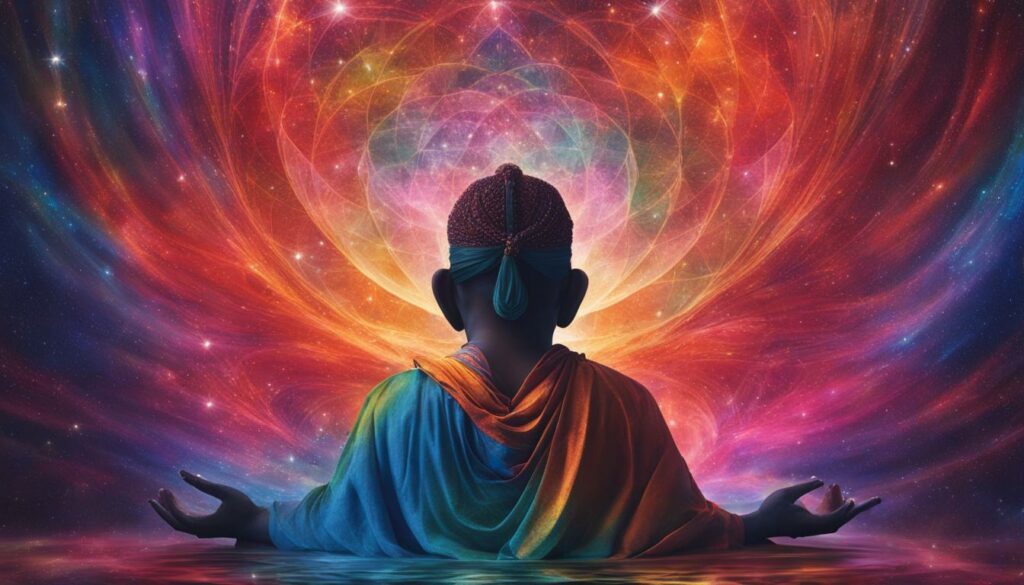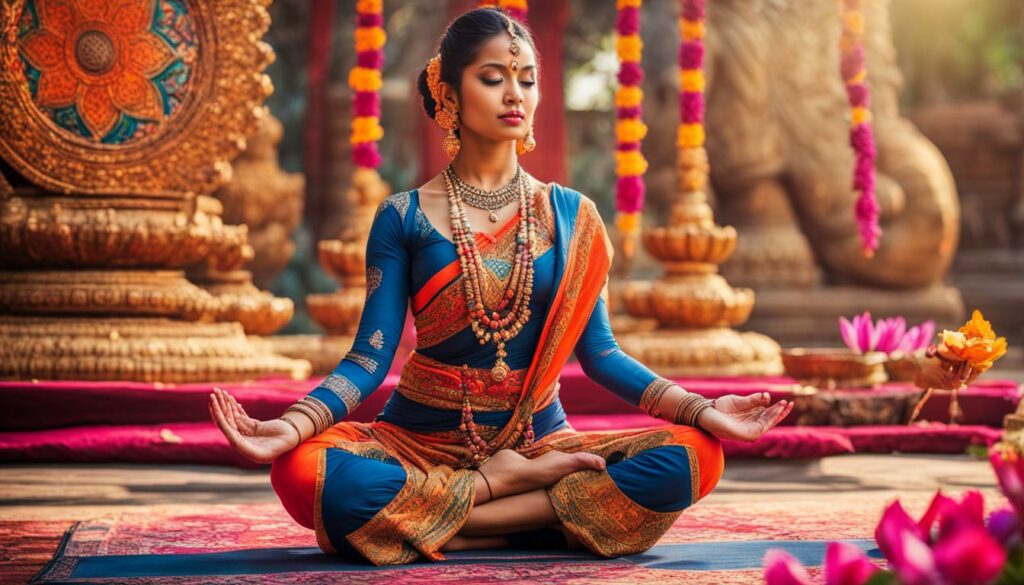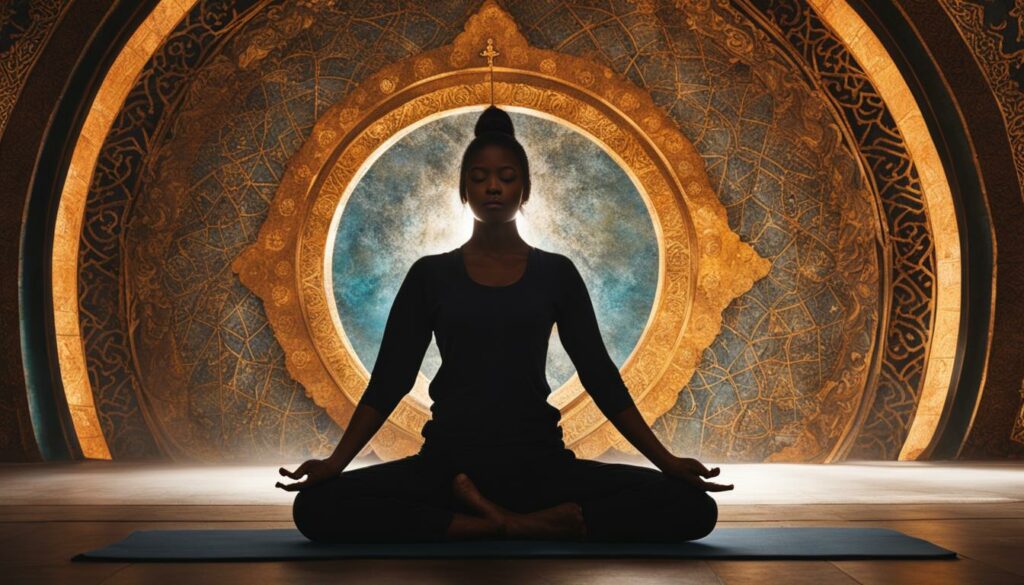As a practice that originated in ancient India, yoga has strong ties to spirituality and religion. Many postures in yoga, or asanas, have connections to gods and goddesses in Hindu mythology. But the question remains: Are Yoga poses meant to worship gods?

Are Yoga Poses Meant to Worship Gods?
There is debate among practitioners and scholars on the significance of yoga poses in worship. Some argue that practicing yoga is a way to connect with the divine, using physical movements as a form of devotion. Others believe that yoga is a non-religious activity that can be practiced solely for physical and mental health benefits.
Regardless of differing opinions, it’s important to understand the roots of yoga and the potential spiritual significance of certain poses. Every individual has their own unique relationship with yoga, and it’s up to them to decide how they approach the practice.
Key Takeaways
- Yoga poses have connections to gods and goddesses in Hindu mythology.
- Debate exists about whether practicing yoga is a form of worship towards these deities.
- Every individual has their own unique relationship with yoga and can approach the practice in their own way.
- Understanding the roots of yoga and the potential spiritual significance of certain poses is important.
- Ultimately, it’s up to the practitioner to decide how they approach yoga and its relationship to spirituality.
Table of Contents
The Origins of Yoga
In order to understand the spiritual meaning behind yoga poses, we must first delve into the origins of this ancient practice. Yoga has its roots in ancient Indian philosophy, specifically in the Vedic texts dating back to 1500 BCE. These texts describe the practice of yoga as a means to achieve spiritual enlightenment and connect with the divine.
Over time, the practice of yoga evolved and evolved as different schools of thought and philosophies emerged. The physical practice of yoga, known as hatha yoga, developed in the 15th century as a way to prepare the body for meditation and spiritual practice. It was during this time that yoga poses, or asanas, began to take on more significant meanings.
The spiritual meaning behind yoga poses is deeply rooted in Hindu mythology and symbolism. Each posture is believed to represent a different aspect of the divine, with some poses inspired by specific deities. For example, the warrior pose, Virabhadrasana, is named after a mythical warrior created by the god Shiva.
Despite its ancient roots, modern yoga has continued to evolve, adapt, and change. Today, there are a multitude of different styles and approaches to yoga, each with its own unique emphasis and interpretation. However, the spiritual foundation of the practice remains at its core, with many practitioners still embracing the spiritual and philosophical aspects of yoga.

The Significance of Yoga Poses in Worship
As we explore the spiritual meaning behind yoga poses, we must address the question of whether yoga poses are meant to be a form of worship towards gods. While the physical practice of yoga can be seen as a way to honor and connect with the divine, it is important to understand that yoga itself is not a religion.
Yoga can be practiced by people of all faiths and backgrounds, and there is no requirement to adhere to any specific religious beliefs or practices. However, it is important to acknowledge and honor the cultural and spiritual traditions from which yoga originated.
Ultimately, the significance of yoga poses in worship is a personal and individual matter. Some practitioners may choose to incorporate spiritual and devotional elements into their practice, while others may approach yoga solely as a physical exercise.
“Yoga is not a religion. It is a science, science of well-being, science of youthfulness, science of integrating body, mind, and soul.” – Amit Ray
Regardless of one’s approach to yoga, it is clear that the spiritual and philosophical aspects of the practice have had a profound impact on its development and evolution over thousands of years.
Yoga as a Physical and Spiritual Practice
Yoga is a unique practice that encompasses both physical exercise and spiritual exploration. It is believed that the practice of yoga can help a person connect with the divine, and certain yoga poses are inspired by deities and used as a way to honor and worship them. This spiritual aspect of yoga is an important part of the practice for many individuals, and they view it as a form of worship.
While yoga poses are not necessarily meant to worship gods, they can be used in this way. The physical movements in yoga can be seen as a way to express devotion and offer reverence to the divine. The connection between yoga poses and gods is an important aspect of the practice for some, and it can enhance their spiritual experience.
Connections between yoga poses and gods
The connection between yoga poses and gods can be traced back to ancient Indian philosophy, where physical postures were developed as a means to connect with the divine. Each yoga pose is believed to have a specific spiritual meaning and is associated with a particular deity.
For example, the tree pose (Vrksasana) is associated with the Hindu god Vishnu, and the downward-facing dog pose (Adho Mukha Svanasana) is associated with the god Shiva.
In some cases, the names of the poses themselves reflect their spiritual significance. The warrior pose (Virabhadrasana), for example, is named after the fierce warrior created by the Hindu god Shiva.
Yoga as a form of worship
The use of yoga as a form of worship is a personal choice for each individual practitioner. While some may view yoga poses as a physical expression of devotion, others may not incorporate this spiritual aspect into their practice at all. However, for those who do view yoga as a form of worship, it can be a powerful and meaningful way to connect with the divine.
At its core, yoga is a physical practice that can help individuals cultivate a sense of awareness and inner peace. Whether it is used as a form of worship or simply as a means of physical exercise and stress relief, the benefits of yoga are numerous.
By exploring the connections between yoga poses and gods, practitioners can deepen their understanding of the practice and its spiritual significance.

Religious Symbolism in Yoga Poses
Yoga has a long history of intertwining physical and spiritual practices. In this section, we will explore the religious symbolism embedded within various yoga poses, revealing how they represent different aspects of the divine.
The Divine Significance of Yoga Postures
Yoga poses, or asanas, have deep spiritual connotations. Each pose is imbued with symbolic meanings that connect to the divine realm. For instance, the Tree Pose represents stability, grounding, and growth, while the Sun Salutation honors the life-giving energy and power of the sun.
Some poses are inspired by deities, making them particularly significant in worship. The Warrior Pose, for example, pays homage to the fierce Hindu god, Lord Shiva, while the Eagle Pose symbolizes the strength and grace of the bird associated with the Greek god, Zeus.
Yoga Poses and Religious Symbolism
There are several yoga poses that are associated with specific religions and their respective deities. The Lotus Pose, for instance, is commonly used in Hinduism and Buddhism as a position for meditation and reflection. This posture represents spiritual purity, enlightenment, and the unfolding of the divine within ourselves.
The Camel Pose, on the other hand, is regarded as a heart-opening posture in yoga and is associated with the Christian tradition. This pose symbolizes the act of surrendering and opening oneself up to the divine love and grace.
The Importance of Religious Symbolism in Yoga
The religious symbolism in yoga poses emphasizes the spiritual nature of the practice, encouraging practitioners to connect with the divine through their bodies. It adds depth and meaning to each posture, helping individuals to tap into their own spirituality and find a deeper purpose in their practice.
Overall, the religious symbolism in yoga postures enriches the practice by providing a way for individuals to honor and connect with the divine. It serves as a reminder that yoga is not just a physical exercise but a spiritual journey towards self-awareness and enlightenment.
Yoga Poses for Connecting with the Divine
In yoga, the physical practice of asanas (poses) is often viewed as a means of connecting with the divine. Through movement and breath, practitioners can cultivate a deeper sense of devotion and tap into a higher spiritual consciousness. Here are a few yoga poses that are believed to facilitate this connection:
| Yoga Pose | Description |
|---|---|
| Downward-Facing Dog | A popular pose that stretches the entire body and calms the mind. In Hindu mythology, dogs are associated with the god Bhairava, who represents transformation and change. |
| Tree Pose | A balancing pose that requires concentration and focus. In Hinduism, the tree is a symbol of life and knowledge, and is often associated with the god Ganesha. |
| Warrior II | A powerful pose that strengthens the legs and opens the chest. In Hindu mythology, the warrior is a symbol of courage and protection. The goddess Durga is often depicted as a warrior, with eight arms and a fierce demeanor. |
These poses, and many others, can be used as physical expressions of devotion. They allow practitioners to embody different aspects of the divine and create a deeper connection with the spiritual realm. By focusing on the symbolism and meaning behind each pose, yogis can infuse their practice with intention and purpose.
However, it’s important to remember that yoga can be practiced in many ways, and not everyone approaches it as a form of worship. Ultimately, the relationship between yoga and the divine is a personal one, and each individual must decide for themselves how they want to incorporate spirituality into their practice.

Yoga as a Non-Religious Practice
While yoga is undoubtedly steeped in spiritual and religious traditions, it has also evolved into a non-religious practice for many individuals. At its core, yoga is a physical and mental discipline that promotes health, well-being, and mindfulness.
For some people, the religious aspects of yoga are an integral part of their practice, while for others, yoga is simply a way to stay fit and release stress. Regardless of one’s beliefs, yoga can offer a wealth of benefits, including improved flexibility, strength, and balance, as well as reduced anxiety and depression.
Some practitioners choose to focus solely on the physical postures, or asanas, without considering their religious significance. They may view yoga as a way to increase strength and flexibility, or as a complement to other forms of exercise.
Others may be drawn to the mindfulness and meditation components of yoga, without necessarily subscribing to any particular religious or spiritual belief system.
It is worth noting, however, that yoga’s religious roots cannot be entirely ignored. Many common yoga poses are named after Hindu deities, and some postures are believed to have been inspired by religious stories and myths. For this reason, some people argue that yoga can never be truly divorced from its religious origins.
Ultimately, the choice to practice yoga as a non-religious or religious activity is a personal one. As yoga continues to evolve and adapt in modern times, it will likely remain a source of debate and discussion within the broader yoga community.

Cultural and Philosophical Aspects of Yoga
Yoga is deeply rooted in the cultural and philosophical traditions of India, where it originated thousands of years ago. As the practice has spread to other cultures and parts of the world, it has become a hybrid of many philosophical and spiritual traditions, making it a truly global phenomenon.
The cultural aspects of yoga are evident in everything from the language used to describe postures and techniques, to the music and clothing associated with the practice. The Sanskrit language, which is the language of ancient Indian texts, is often used to name postures and techniques within yoga. This linguistic tradition carries with it the cultural significance of the practice and highlights its roots in ancient Indian philosophy.
The philosophical aspects of yoga are also deeply ingrained within the practice. Yoga philosophy is based on the idea of self-realization and the pursuit of spiritual enlightenment. The practice is designed to help practitioners achieve a state of blissful awareness that transcends the limits of the physical body and mind.
| Philosophical Concept | Explanation |
|---|---|
| Karma | The law of cause and effect, which states that every action has a consequence. |
| Dharma | One’s duty or purpose in life. |
| Moksha | The ultimate goal of life, which is the attainment of liberation from the cycle of birth and death. |
These philosophical concepts are often integrated into yoga classes and teachings, as they represent the deeper meaning and purpose behind each posture and movement.
Despite its cultural and philosophical roots, yoga has also been adapted and modified in many different cultures and contexts. For example, in the United States, yoga has been integrated into mainstream fitness classes and has been stripped of much of its traditional cultural and philosophical significance.
While some practitioners embrace the cultural and philosophical aspects of yoga, others view it solely as a physical practice devoid of religious or cultural overtones.
Ultimately, the cultural and philosophical aspects of yoga are deeply entwined with the practice, but the extent to which practitioners engage with them varies widely. No matter how one approaches yoga, however, it remains a powerful tool for physical and spiritual growth and self-realization.

Modern Interpretations of Yoga
As the popularity of yoga continues to grow, so do the varied interpretations of its practice. While some view yoga as a purely physical exercise, others incorporate spiritual elements and see it as a means of connecting with the divine.
One modern interpretation of yoga is as a mindfulness practice, with a focus on stress reduction and mental health. This approach often emphasizes slow, meditative movements and breathing exercises.
Another approach is power yoga, which incorporates fast-paced movements and more challenging poses for a more intense workout. This style of yoga often places less emphasis on spirituality and more on physical fitness.
Some practitioners combine yoga with other forms of exercise, such as weightlifting or cardio, to create a well-rounded fitness routine that includes mindfulness and stress relief.
Regardless of the interpretation, modern yoga has become more accessible and inclusive, with studios and online classes catering to a diverse range of individuals and their unique needs.
“The yoga community has evolved to incorporate different interpretations and approaches to the practice, making it more accessible and beneficial for a wider range of individuals.”
Debates and Perspectives on Yoga as Worship
Yoga has always been a subject of debate when it comes to its connection to religion, specifically whether or not yoga poses are meant to worship gods. While some argue that yoga is a form of worship, others believe it to be a purely physical practice devoid of any connection to religion.
One perspective on yoga as worship is that it is a way to connect with the divine through physical movement and meditation. Proponents of this view argue that yoga poses are inspired by deities and that practicing them honors and worships these divine beings.
They believe that by dedicating their practice to a specific deity, they are able to deepen their connection with the divine and experience spiritual growth.
On the other hand, some argue that yoga should not be viewed as a religious practice, but rather as a means of self-exploration and physical fitness.
They believe that yoga is accessible to people of all beliefs and backgrounds and should not be limited to those who adhere to a particular religion. Furthermore, they argue that the spiritual aspects of yoga are optional and can be practiced or ignored based on individual preference.
The Debate Over Cultural Appropriation
Another perspective on yoga as worship revolves around the issue of cultural appropriation. Some argue that the commercialization of yoga in Western culture has led to the commodification of an ancient cultural practice and the erasure of its roots in Hinduism.
They contend that the appropriation of yoga by Western society has led to the commodification of Hindu culture and reinforces harmful stereotypes of the East as exotic and mystical. Others argue that yoga has evolved and adapted over time, and that it is not limited to any particular culture or religion.
Despite these debates, yoga continues to be a popular practice around the world, with millions of practitioners engaging in the physical and spiritual aspects of yoga on a daily basis.
Whether one views yoga as a religious practice, a form of physical fitness, or a means of cultural exploration, it remains a significant and transformative practice for many.

Conclusion
After exploring the ancient practice of yoga and its relationship to worship and the divine, we can conclude that the answer to the question, “Are yoga poses meant to worship gods?” is not a simple one.
While yoga poses were initially developed as a means of connecting with the divine and certain postures were inspired by deities, the practice has evolved to encompass a range of perspectives and beliefs, some of which do not involve religious worship.
The cultural and philosophical aspects of yoga have influenced its evolution and adaptation across various traditions, both embracing and transcending religious boundaries. Today, there are different interpretations of yoga, including those that focus solely on physical fitness and those that incorporate spiritual elements.
While some may view yoga as a form of worship towards gods, others approach it as a purely physical and non-religious activity. In the end, it is up to each individual to determine their personal relationship with yoga and spirituality.
Regardless of one’s perspective, it is clear that yoga poses hold deep significance and symbolism, representing different aspects of the divine and facilitating a deeper connection with the self and the world around us. Whether one practices yoga for its physical benefits, its spiritual elements, or both, it remains a powerful tool for personal growth and transformation.
To conclude, while the origins of yoga may be rooted in the desire to connect with the divine, the practice has evolved to encompass a diverse range of perspectives and beliefs. Ultimately, whether one sees yoga poses as meant to worship gods or not is a matter of personal interpretation and belief.
Magda Felcio, a certified Vinyasa Flow Yoga teacher in Brazil, is deeply passionate about the grace and transformation this practice offers. With a commitment to empowering her students, she creates harmonious and flowing sequences that focus on alignment and mindfulness.

